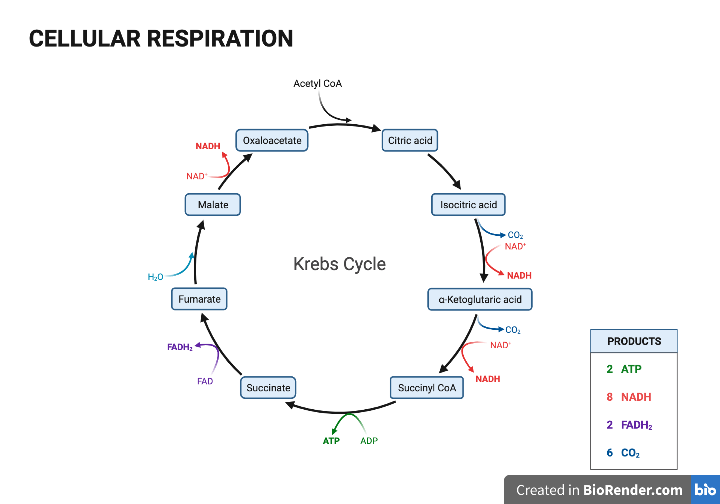Energy, which can be defined as the ability to perform a work, can be of various types: potential, radiant, thermal, electrical. All organisms require energy to perform certain cellular functions essential for survival: transport of solutes across the cytoplasmic membrane, movement, biosynthesis …
Man, together with animals and most of the bacteria, fungi and protozoa, is a heterotrophic organism that is unable to synthesize biomolecules, in fact, it must take them by feeding; it is therefore a chemoheterotrophic organism that produces energy through the oxidation of various organic substances in the reactions that are part of a metabolic cycle.
Cellular metabolic cycles are sequences of chemical reactions catalyzed by specific enzymes in which the final product of a chemical reaction acts as a substrate for the subsequent enzymatic reaction. The individual products of the reaction that are part of a metabolic cycle are called metabolites; each metabolite is chemically modified, by addition, removal or rearrangement of chemical groups, until the final product of the entire metabolic cycle is obtained. These final products can be secreted by the cell and used as substrates in other metabolic reactions.
Metabolic cycles are divided into two types: anabolic and catabolic. The anabolic (biosynthetic) ones consume energy to build cellular components, the catabolic ones are represented by sequences of chemical reactions whose function is to release free energy through the degradation or oxidation of organic molecules.
With anaerobic glycolysis, the breakdown of glucose provides only a part of the energy, made available as ATP (energy molecule of the cell). Most of the ATP generated during metabolism derives from the aerobic breakdown of glucose. This process begins with the complete oxidation of glucose derivatives to carbon dioxide and is carried out through a series of reactions, called the citric acid cycle, also known as the tricarboxylic acid cycle or Krebs cycle.
THE FINAL METABOLIC ROUTE OF NUTRIENT OXIDATION
The citric acid cycle is the final metabolic pathway of oxidation of the organic molecules present in the nutrients: carbohydrates, fatty acids and amino acids.
The citric acid cycle is also an important source of precursors for the biosynthesis of other molecules, such as amino acids, purine and pyrimidine bases (which are used for the synthesis of nucleic acids: DNA and RNA).
Nutrients consist of organic compounds that can be oxidized, that is, they can lose electrons. The citric acid cycle includes a series of redox reactions, which lead to the oxidation of the acetyl CoA units into carbon dioxide. This oxidation releases high-energy electrons, which will be used for the synthesis of ATP.
THE CROSSROADS BETWEEN GLYCOLYSIS AND THE KREBS CYCLE
Carbohydrates, especially glucose, are processed in pyruvate during glycolysis.

Before the Krebs cycle begins, pyruvate is transported into the mitochondria (cell organelles) and oxidized to acetate which becomes part of the coenzyme A (CoA) molecule, activating.
The acetyl group of acetyl CoA is enzymatically transferred onto the oxaloacetate, with the formation of citrate. Through this reaction the Krebs cycle begins and the CoA is regenerated; the cycle then continues with 8 other reactions, summarized at the side.
The citric acid cycle itself does not generate significant amounts of ATP and does not include oxygen among its reactants, it removes electrons from acetyl CoA, these electrons reduce oxygen in the following oxidative phosphorylation and serve for subsequent energy production.
The citric acid cycle, together with oxidative phosphorylation, provides most of the energy used by human cells, more than 90%.
Ultimately, one acetyl unit generates approximately 10 molecules of ATP, while anaerobic glycolysis generates only 2 molecules of ATP for an entire molecule of glucose. Molecular oxygen does not participate directly in the citric acid cycle. However, the cycle only operates under aerobic conditions; glycolysis can take place both in aerobic and anaerobic conditions, while the citric acid cycle is a strictly aerobic process.
The complete oxidation of glucose to carbon dioxide and water that occurs in respiration provides 38 molecules of ATP.
The speed with which the cycle takes place is regulated by the energy charge that the cell possesses and by the abundance of biosynthetic intermediates present in the cell itself.
General Microbiology, 1992 Medical books, R.F.Boyd
Biochemistry, 2020 Zanichelli, L. Stryer et al



